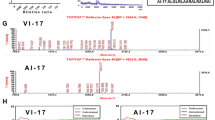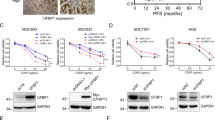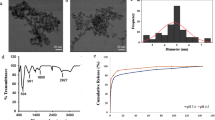Abstract
Previous studies highlighted that aminopeptidase N (APN)/CD13 acts as a scavenger in the survival of hepatocellular carcinoma (HCC) stem cells by reducing reactive oxygen species (ROS) levels. Hence, it has been proposed that APN/CD13 inhibition can increase cellular ROS levels and sensitize cells to chemotherapeutic agents. Although ubenimex, also known as bestatin, competitively inhibits proteases such as APN/CD13 on the cellular membrane and it is clinically used for patients with acute myeloid leukemia and lymphedema, research has demonstrated that higher concentrations of the agent induce the death of APN/CD13+ HCC stem cells. In this study, we developed a poly(ethylene glycol)–poly(lysine) block copolymer–ubenimex conjugate (PEG-b-PLys(Ube)) to increase the efficacy of reagents in APN/CD13+ cancer stem cells. Exposure to PEG-b-PLys(Ube) increased the intracellular ROS concentration by inhibiting APN enzyme activity, permitting the induction of apoptosis and attenuation of HCC cell proliferation. In addition, PEG-b-PLys(Ube) exhibited a relatively stronger antitumor effect in mice than PEG-b-PLys alone or phosphate-buffered saline. Moreover, an isobologram analysis revealed that combinations of fluorouracil, cisplatin, or doxorubicin with PEG-b-PLys(Ube) exhibited synergistic effects. This study demonstrated that PEG-b-PLys(Ube) does not impair the properties of ubenimex and exerts a potent antitumor effect.
This is a preview of subscription content, access via your institution
Access options
Subscribe to this journal
Receive 50 print issues and online access
$259.00 per year
only $5.18 per issue
Buy this article
- Purchase on Springer Link
- Instant access to full article PDF
Prices may be subject to local taxes which are calculated during checkout








Similar content being viewed by others
References
Colvin H, Mizushima T, Eguchi H, Takiguchi S, Doki Y, Mori M. Gastroenterological surgery in Japan: The past, the present and the future. Ann Gastroenterol Surg. 2017;1:5–10.
Wada H, Eguchi H, Nagano H, Kubo S, Nakai T, Kaibori M, et al.Perioperative allogenic blood transfusion is a poor prognostic factor after hepatocellular carcinoma surgery: a multi-center analysis. Surg Today. 2017;48:73–9.
Tomimaru Y, Wada H, Eguchi H, Tomokuni A, Hama N, Kawamoto K, et al. Clinical significance of surgical resection of metastatic lymph nodes from hepatocellular carcinoma. Surg Today. 2015;45:1112–20.
Sun JH, Luo Q, Liu LL, Song GB. Liver cancer stem cell markers: progression and therapeutic implications. World J Gastroenterol. 2016;22:3547–57.
Abou-Alfa GK. Hepatocellular carcinoma: molecular biology and therapy. Semin Oncol. 2006;33(6Suppl 11):S79–83.
Vinogradov S, Wei X. Cancer stem cells and drug resistance: the potential of nanomedicine. Nanomed (Lond). 2012;7:597–615.
Bao B, Ahmad A, Azmi AS, Ali S, Sarkar FH. Overview of cancer stem cells (CSCs) and mechanisms of their regulation: implications for cancer therapy. Curr Protoc Pharmacol. 2013;14:25. Chapter 14:Unit.
Ji J, Wang XW. Clinical implications of cancer stem cell biology in hepatocellular carcinoma. Semin Oncol. 2012;39:461–72.
Ishii H, Iwatsuki M, Ieta K, Ohta D, Haraguchi N, Mimori K, et al. Cancer stem cells and chemoradiation resistance. Cancer Sci. 2008;99:1871–7.
Hu YFL. Targeting cancer stem cells: a new therapy to cure cancer patients. Am J Cancer Res. 2012;2:340–56.
Karsten U, Goletz S. What makes cancer stem cell markers different? Springerplus. 2013;2:301
Ma S, Chan KW, Hu L, Lee TK, Wo JY, Ng IO, et al. Identification and characterization of tumorigenic liver cancer stem/progenitor cells. Gastroenterology. 2007;132:2542–56.
Yang W, Yan HX, Chen L, Liu Q, He YQ, Yu LX, et al. Wnt/beta-catenin signaling contributes to activation of normal and tumorigenic liver progenitor cells. Cancer Res. 2008;68:4287–95.
Ma S, Chan KW, Lee TK, Tang KH, Wo JY, Zheng BJ, et al. Aldehyde dehydrogenase discriminates the CD133 liver cancer stem cell populations. Mol Cancer Res. 2008;6:1146–53.
Yang ZF, Ho DW, Ng MN, Lau CK, Yu WC, Ngai P, et al. Significance of CD90+cancer stem cells in human liver cancer. Cancer Cell. 2008;13:153–66.
Chen MW, Hua KT, Kao HJ, Chi CC, Wei LH, Johansson G, et al. H3K9 histone methyltransferase G9a promotes lung cancer invasion and metastasis by silencing the cell adhesion molecule Ep-CAM. Cancer Res. 2010;70:7830–40.
Zhu Z, Hao X, Yan M, Yao M, Ge C, Gu J, et al. Cancer stem/progenitor cells are highly enriched in CD133+CD44+population in hepatocellular carcinoma. Int J Cancer. 2010;126:2067–78.
Zhao W, Wang L, Han H, Jin K, Lin N, Guo T, et al. 1B50-1, a mAb raised against recurrent tumor cells, targets liver tumor-initiating cells by binding to the calcium channel alpha2delta1 subunit. Cancer Cell. 2013;23:541–56.
Oikawa T, Kamiya A, Zeniya M, Chikada H, Hyuck AD, Yamazaki Y, et al. Sal-like protein 4 (SALL4), a stem cell biomarker in liver cancers. Hepatology. 2013;57:1469–83.
Liu S, Li N, Yu X, Xiao X, Cheng K, Hu J, et al. Expression of intercellular adhesion molecule 1 by hepatocellular carcinoma stem cells and circulating tumor cells. Gastroenterology. 2013;144:1031–41.
Haraguchi N, Ishii H, Mimori K, Tanaka F, Ohkuma M, Kim HM, et al. CD13 is a therapeutic target in human liver cancer stem cells. J Clin Invest. 2010;120:3326–39.
Wickstrom M, Larsson R, Nygren P, Gullbo J. Aminopeptidase N (CD13) as a target for cancer chemotherapy. Cancer Sci. 2011;102:501–8.
Yamashita M, Wada H, Eguchi H, Ogawa H, Yamada D, Noda T, et al. A CD13 inhibitor, ubenimex, synergistically enhances the effects of anticancer drugs in hepatocellular carcinoma. Int J Oncol. 2016;49:89–98.
Sekine KFH, Abe F. Induction of apoptosis by bestatin (ubenimex) in human leukemic cell lines. Leukemia. 1999;13:729–34.
Osada K, Christie RJ, Kataoka K. Polymeric micelles from poly(ethylene glycol)-poly(amino acid) block copolymer for drug and gene delivery. J R Soc Interface. 2009;6(Suppl 3):S325–39.
Mishra P, Nayak B, Dey RK. PEGylation in anti-cancer therapy: An overview. Asian J Pharm Sci. 2016;11:337–48.
Jhaveri AM, Torchilin VP. Multifunctional polymeric micelles for delivery of drugs and siRNA. Front Pharmacol. 2014;5:77.
Look ATAR, Shapiro LH, Peiper SC. Human myeloid plasma membrane glycoprotein CD13 (gp150) is identical to aminopeptidase N. J Clin Invest. 1989;83:1299–307.
Luan Y XW. The structure and main functions of aminopeptidase N. Curr Med Chem. 2007;14:639–47.
Dando I, Cordani M, Dalla Pozza E, Biondani G, Donadelli M, Palmieri M. Antioxidant mechanisms and ROS-related microRNAs in cancer stem cells. Oxid Med Cell Longev. 2015;2015:425708.
Yasunaga M, Fujita Y, Saito R, Oshimura M, Nakajima Y. Continuous long-term cytotoxicity monitoring in 3D spheroids of beetle luciferase-expressing hepatocytes by nondestructive bioluminescence measurement. BMC Biotechnol. 2017;17:54.
Yamada N, Honda Y, Takemoto H, Nomoto T, Matsui M, Tomoda K, et al. Engineering tumour cell-binding synthetic polymers with sensing dense transporters associated with aberrant glutamine metabolism. Sci Rep. 2017;7:6077.
Schwabe RF, Brenner DA. Mechanisms of Liver Injury. I. TNF-alpha-induced liver injury: role of IKK, JNK, and ROS pathways. Am J Physiol Gastrointest Liver Physiol. 2006;290:G583–9.
Stange T, Kettmann U, Holzhausen H-J. Immunoelectron microscopic single and double labelling of aminopeptidase N (CD 13) and dipeptidyl peptidase IV (CD 26). Acta Histochem. 1996;98:323–31.
Umezawa HAT, Suda H, Hamada M, Takeuchi TBestatin. an inhibitor of aminopeptidase B, produced by actinomycetes. J Antibiot (Tokyo). 1976;29:97–9.
Bruley-Rosset MFI, Kiger N, Schulz J, Mathé G. Restoration of impaired immune functions of aged animals by chronic bestatin treatment. Immunology. 1979;38:75–83.
Terauchi M, Kajiyama H, Shibata K, Ino K, Nawa A, Mizutani S, et al. Inhibition of APN/CD13 leads to suppressed progressive potential in ovarian carcinoma cells. BMC Cancer. 2007;7:140.
Takada M, Fukuoka M, Negoro S, Kusunoki Y, Matsui K, Masuda N, et al. Combination therapy with bestatin in inoperable lung cancer: a randomized trial. Acta Oncol (Madr). 2009;29:821–5.
Niimoto MST, Toi M, Nishiyama M, Hirai T, Yanagawa E, Hattori T. Prospective randomized controlled study on bestatin in resectable gastric cancer--third report. Jpn J Surg. 1990;20:186–91.
Kumamoto YTT, Tamiya T, Takatsuka K, Furuya S, Yokoyama E, Honma A, et al. Clinical research on prevention of recurrence of superficial bladder cancer--comparative study on clinical efficacy of bleomycin intravesical instillation and bestatin. Hinyokika Kiyo. 1985;31:1861–83.
S. O. A review of clinical studies of bestatin. Recent Results Cancer Res. 1980;75:126–32.
Hitzerd SM, Verbrugge SE, Ossenkoppele G, Jansen G, Peters GJ. Positioning of aminopeptidase inhibitors in next generation cancer therapy. Amino Acids. 2014;46:793–808.
Mi P, Yanagie H, Dewi N, Yen HC, Liu X, Suzuki M, et al. Block copolymer-boron cluster conjugate for effective boron neutron capture therapy of solid tumors. J Control Release. 2017;254:1–9.
Fischer DLY, Ahlemeyer B, Krieglstein J, Kissel T. In vitro cytotoxicity testing of polycations: influence of polymer structure on cell viability and hemolysis. Biomaterials. 2003;24:1121–31.
Lee HJJ, Park TG. PEG grafted polylysine with fusogenic peptide for gene delivery: high transfection efficiency with low cytotoxicity. J Control Release. 2002;79:283–91.
Webster R, Didier E, Harris P, Siegel N, Stadler J, Tilbury L, et al. PEGylated proteins: evaluation of their safety in the absence of definitive metabolism studies. Drug Metab Dispos. 2007;35:9–16.
Rusznyak LFM, Szabo G. Lymphatics and lymph circulation. In: Youlten L, editor. Physiology and pathology. 2nd ed. Pergamon Press; Oxford, UK. 1967. p. 475–510.
Tanjaya J, Zhang Y, Lee S, Shi J, Chen E, Ang P, et al. Efficacy of intraperitoneal administration of PEGylated NELL-1 for bone formation. Biores Open Access. 2016;5:159–70.
Ribas A, Dummer R, Puzanov I, VanderWalde A, Andtbacka RHI, Michielin O, et al. Oncolytic virotherapy promotes intratumoral T cell infiltration and improves anti-PD-1 immunotherapy. Cell. 2017;170:1109–19.
Talmadge JELB, Pennington R, Long C, Phillips H, Schneider M, Tribble H. Immunomodulatory and therapeutic properties of bestatin in mice. Cancer Res. 1986;46:4505–10.
Yamamoto TNH, Sakon M, Wada H, Eguchi H, Kondo M, Damdinsuren B, et al. Partial contribution of tumor necrosis factor-related apoptosis-inducing ligand (TRAIL) TRAIL receptor pathway to antitumor effects of interferon-alpha 5-fluorouracil against hepatocellular carcinoma. Clin Cancer Res. 2004;10:7884–95.
Ding M, Cao X, Xu HN, Fan JK, Huang HL, Yang DQ, et al. Prostate cancer-specific and potent antitumor effect of a DD3-controlled oncolytic virus harboring the PTEN gene. PLoS ONE. 2012;7:e35153.
Bijnsdorp IV, Giovannetti E, Peters GJ. Analysis of drug interactions. Methods Mol Biol. 2011;731:421–34.
Acknowledgements
We thank M. Ozaki and Y. Noguchi for technical assistance and the laboratory staff for their helpful discussions.
Funding
This work received financial support from grants-in-aid for Scientific Research from the Ministry of Education, Culture, Sports, Science, and Technology (grant no. 17H04282; 17K19698; 16K15615; 15H05791; P-DIRECT; P-CREATE; AMED−Japan Cancer Research Project).
Author contributions
Conception and design: RT, MK, HT, NN, HI. Development of methodology: RT, MK, NN, HI. Acquisition of the data (e.g., provided animals, acquired and managed patients, provided facilities): RT, MK, HT, TN, AA, JK, YU, KM, KA, TO, NN, HI. Analysis and interpretation of the data (e.g., statistical analysis, biostatistics, computational analysis): RT, MK, NH, YI, DY, DS, TA, TK, KK, KG, SK, TS, YD, MM, HI. Writing, review, and/or revision of the manuscript: RT, MK, HE, HT, TN, NH, HI. Study supervision: MM, HI.
Author information
Authors and Affiliations
Corresponding authors
Ethics declarations
Conflict of interest
YD, MM, HI received Institutional endowments were received from Taiho Pharmaceutical Co., Ltd., Unitech Co., Ltd. (Chiba, Japan), IDEA Consultants, Inc. (Tokyo, Japan), and Kinshu-kai Medical Corporation (Osaka, Japan); DS, TK, TS, YD, MM received Chugai Co., Ltd., Yakult Honsha Co., Ltd., and Merck & Co., Ltd (YD, MM, TS). The remaining authors declare that they have no conflict of interest.
Electronic supplementary material
Rights and permissions
About this article
Cite this article
Toshiyama, R., Konno, M., Eguchi, H. et al. Poly(ethylene glycol)–poly(lysine) block copolymer–ubenimex conjugate targets aminopeptidase N and exerts an antitumor effect in hepatocellular carcinoma stem cells. Oncogene 38, 244–260 (2019). https://doi.org/10.1038/s41388-018-0406-x
Received:
Revised:
Accepted:
Published:
Issue Date:
DOI: https://doi.org/10.1038/s41388-018-0406-x



